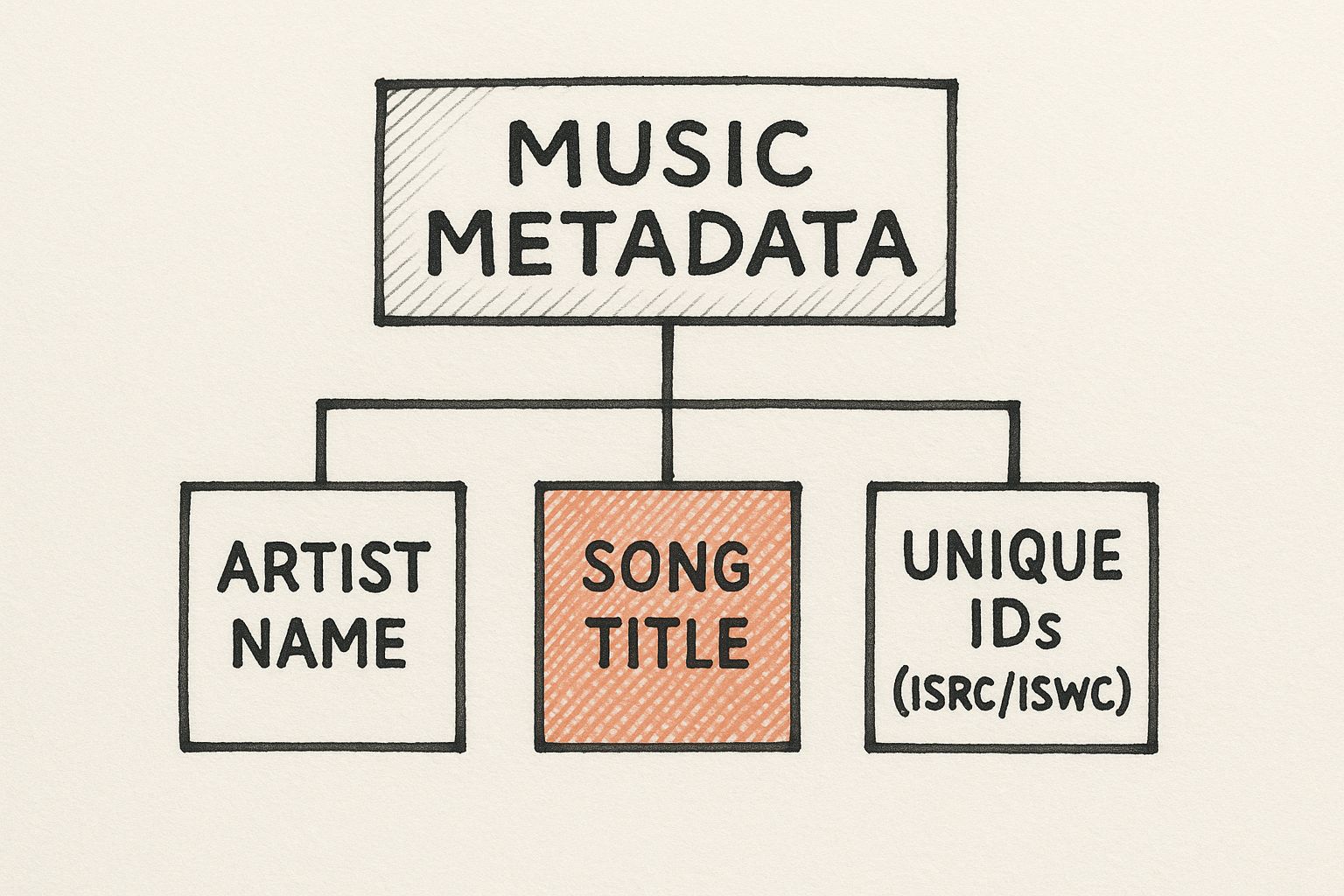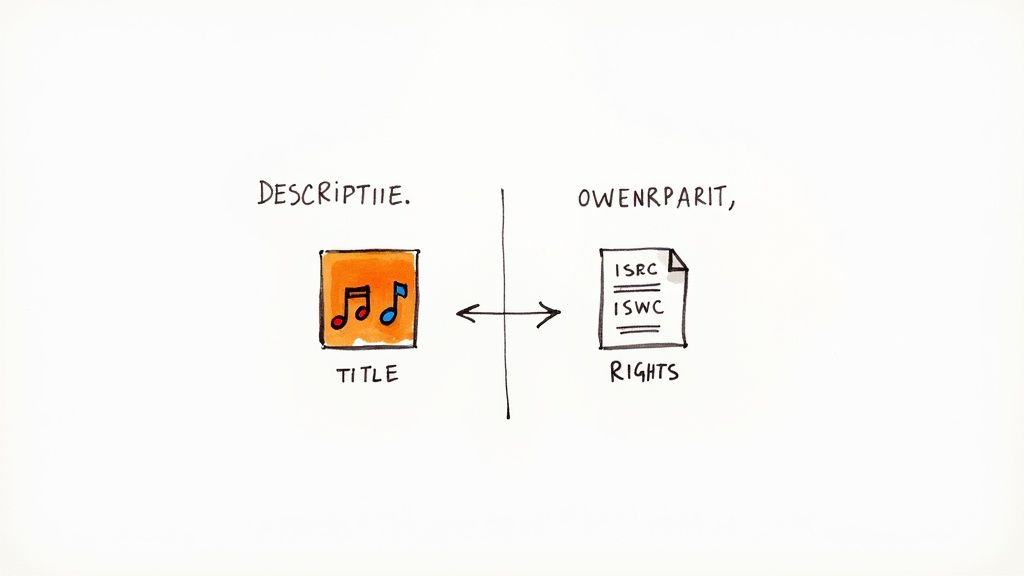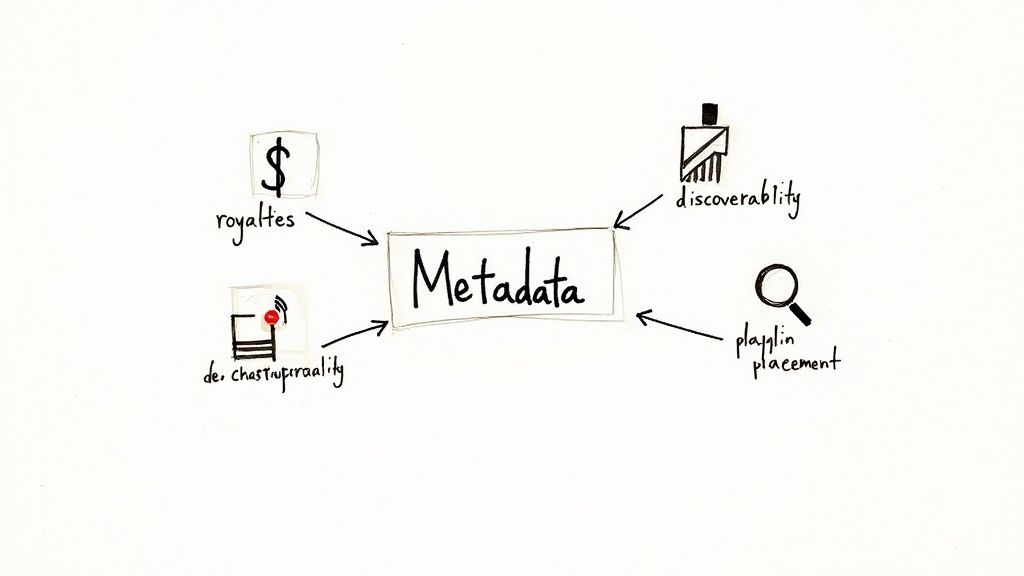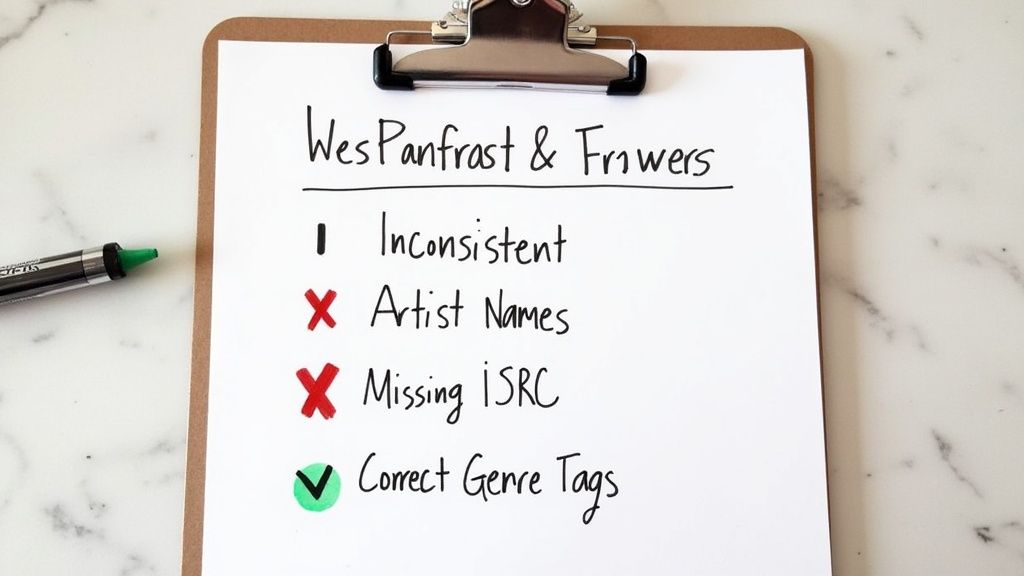What Is Music Metadata? Essential Guide for Artists & Labels
- nick
- Oct 17
- 12 min read
Music metadata is essentially the digital DNA of your song. It's all the crucial information like the artist name, song title, writers, and release date that tells platforms like Spotify who made the music, how to sort it, and—most importantly—who gets paid when it's streamed.
Your Song's Digital Passport
Think of music metadata as your song's passport. Just like a passport holds all the vital info to identify a person—name, date of birth, nationality—metadata does the same for your track. Without it, your song is anonymous, lost in a sea of millions of other tracks with no way to trace it back to its creators or owners.
This "passport" is what allows your music to travel across the digital world. It's the data that fills in the fields you see on Spotify: the track title, the album art, and the artist profile it links to. But it goes much deeper than that, holding all the hidden info that makes sure royalties are sent to the right people.
Here’s a simple visual to break down the core pieces of music metadata.

As you can see, the most basic level of metadata connects a track's identity (the title) to its creator (the artist) and its official registration numbers (unique IDs).
So, Why Does This Digital DNA Matter?
Clean, correct music metadata acts like a unique fingerprint, letting streaming services organize, categorize, and properly pay out royalties. When this data is wrong or missing, the financial hit can be massive. In fact, inaccurate metadata is responsible for millions of dollars in lost or misdirected royalties every single year, which makes getting it right a critical part of your career.
This isn't just about boring administrative details; it's about your income. Every stream generates fractions of a penny, and without the right metadata, that money simply can't find its way back to you.
Getting this right from the start is one of the smartest moves you can make as an artist. It ensures that when your song gets played, you get both the credit and the cash.
To help you get a clearer picture, here's a quick rundown of the most important metadata fields and what they do.
Key Metadata Fields at a Glance
Metadata Field | What It Is | Why It Matters |
|---|---|---|
Song Title | The name of your track. | The primary way listeners find and identify your song. |
Artist Name(s) | Who performed the song (primary and featured artists). | Links the track to your Spotify for Artists profile and ensures proper credit. |
Songwriter(s) & Composer(s) | The people who wrote the lyrics and music. | Absolutely crucial for paying out publishing royalties. Without this, writers don't get paid. |
Album / Release Title | The name of the EP or album the song belongs to. | Groups your songs together into a single project. |
Release Date | The date the music was made available to the public. | Helps with charting, new release playlists, and tracking performance over time. |
ISRC Code | International Standard Recording Code. A unique ID for each recording. | The "fingerprint" for a specific master recording. It's how platforms track streams and sales for your version of a song. |
ISWC Code | International Standard Musical Work Code. A unique ID for the underlying composition. | The "fingerprint" for the song itself (lyrics/melody). It ensures songwriters and publishers are paid no matter who records it. |
Record Label | The company that released the music. | Important for rights management and royalty splits. |
Each of these fields plays a specific role in making sure your music is properly identified and monetized across the globe.
For a deeper dive into how this all connects to getting paid, check out our guide on how to publish your music and collect songwriting royalties.
Breaking Down the Two Sides of Music Metadata
To really get what music metadata is, it helps to split it into two main "families," each with a specific job. Think of it like this: you have the public-facing info versus the behind-the-scenes legal paperwork. You need both, but they do completely different things.

This split is the absolute foundation of how the music industry tracks and pays out for every single song. If you want to get paid correctly and have your music actually found by listeners, getting both sides right isn't just important—it's everything.
Descriptive Metadata: The Public Identity
First up is descriptive metadata. This is all the stuff a listener sees and interacts with on a platform like Spotify. It’s basically the digital version of an album's cover art and liner notes.
What it includes: The track title, primary artist, any featured artists, the genre, album name, and release date.
Its primary job: To help people and algorithms discover your music. When your descriptive data is on point, your song shows up in the right searches and gets recommended to potential fans.
Without solid descriptive metadata, your track is practically invisible. It’s the info that answers the simple question, "What song is this and who made it?"
Ownership Metadata: The Business Blueprint
Next, we have ownership metadata, which is all the backstage stuff. Think of this as the deed to your house—it’s the legally binding info that proves who owns what and who gets paid when the song is played. Listeners almost never see this, but it’s the lifeblood of the music business.
This data clarifies who wrote the song (the composition) and who owns the actual recording of it (the master). These are two separate copyrights, and each gets its own identifier to make sure royalties go to the right people.
Here's a simple way to remember it: The song is the blueprint (lyrics and melody), while the recording is the finished house built from that blueprint. One song can have tons of different recordings.
Take Whitney Houston’s iconic version of "I Will Always Love You." That's a master recording. But the composition—the song itself—was written by Dolly Parton. Thanks to crystal-clear ownership data, both of them earn money every time that track gets played.
This side of metadata relies on two crucial codes:
ISRC (International Standard Recording Code): This is a unique fingerprint for the master recording. Your studio version, a live version, and a sick remix of the same track will each have a different ISRC.
ISWC (International Standard Musical Work Code): This is the unique code for the underlying composition—the song itself. No matter how many people cover or remix your song, the ISWC never changes.
How Accurate Metadata Drives Your Music Career
Think of bad music metadata as more than just a typo—it's a direct hit to your wallet and your future. Honestly, getting this data right from the very beginning is one of the smartest things you can do for your career. It’s what turns your art into a business that actually pays the bills.

Here's an easy way to picture it: Every single stream, radio spin, or public play generates a tiny payment. Accurate metadata is the GPS that steers those payments straight into your bank account. Without it, your cash just disappears into the industry's "black box" of unclaimed royalties.
Securing Your Royalties
The most direct impact of solid metadata? Your income. Every track has a whole web of people who own a piece of it—songwriters, publishers, performers, labels, you name it. When you list every single contributor correctly, you make sure that every stream gets split and paid out the right way.
If you forget to list a co-writer or even just misspell a publisher's name, you've created a dead end. The money literally has nowhere to go. It’s crucial to get this right, and you can dive deeper into how it all works in our complete guide explaining music royalties for artists. Simply put, clean data is the only way your streams become a reliable paycheck.
Boosting Discoverability and Reach
Getting paid is huge, but good metadata is also your secret marketing weapon. It’s the language algorithms on platforms like Spotify use to understand what your music is and who it’s for.
Think about it: when an algorithm knows your song’s genre, mood, instrumentation, and influences, it can confidently place it on major editorial playlists like Discover Weekly or RapCaviar. That kind of exposure is priceless, putting you in front of thousands of potential new fans without you lifting a finger.
This visibility also opens up the world of sync licensing. Music supervisors searching for that perfect track for a movie or a commercial? They live and die by metadata tags to find what they need. A song with detailed tags is a song that can be found, creating opportunities you would have otherwise completely missed out on.
The global music market is absolutely massive, with recorded music revenues hitting $18.3 billion in just the first half of 2025. In a system this big, metadata is the essential plumbing that makes everything work, from royalty checks to personalized playlists. You can read the full research on global music revenue growth on midiaresearch.com. Managing billions of daily streams would be pure chaos without it.
When you invest time into getting your metadata right, you’re not just doing boring admin work. You're building the foundation for a long-term, profitable music career.
Common Metadata Mistakes That Cost Artists Money
It’s a tough pill to swallow, but countless artists are leaving money on the table because of simple, preventable data errors. Think of it like sending a package with a smudged address—no matter how valuable the contents, it’s just not going to get where it needs to go. A tiny mistake in your music metadata can cause major payment delays or, even worse, make your royalties vanish into thin air.

These slip-ups don’t just hit your bank account; they hurt your professional image. When your data is a mess, it makes it harder for platforms, potential fans, and industry contacts to find and track your work. A clean digital footprint isn't just nice to have—it's absolutely essential for building a career that lasts.
Inconsistent Naming and Credits
One of the most common—and most damaging—mistakes is inconsistency. If you release one track as "J. Doe" and the next as "John Doe," you've just created two separate digital identities. This splits your streams, confuses listeners, and fractures your catalog across every single platform.
The same exact problem pops up with collaborators. Crediting a producer by their nickname on one release and their legal name on another creates a messy paper trail that makes royalty payouts a nightmare for everyone involved.
Crucial Takeaway: Every single piece of data you enter must be identical across every single release. Consistency is the bedrock of a professional music catalog that ensures everyone gets paid correctly and on time.
Overlooking Essential Codes and Splits
Beyond just names, other critical bits of data often get missed entirely. Forgetting to embed the correct ISRC code in your master recording is like publishing a book without an ISBN. It becomes nearly impossible for systems to accurately track its sales and usage across the globe.
Even more serious are disputes over songwriter splits. Before you even think about releasing a track, every single contributor needs to agree on their percentage shares, and those splits must be documented perfectly. Trying to fix this after the fact is a recipe for disaster and can lead to some really ugly situations.
To help you sidestep these costly mistakes, run through this quick checklist before every single release:
Consistent Artist Names: Is your name and any featured artists' names spelled exactly the same way they appear everywhere else?
Accurate Songwriter Splits: Have all the writers signed off on their percentages? Are they listed correctly in the metadata?
Correct ISRC and ISWC: Is the right ISRC embedded in the master recording? Is the composition registered with its unique ISWC?
Detailed Genre and Mood Tags: Did you add specific tags that will help Spotify’s algorithm understand who to show your music to?
Complete Contributor Credits: Are the producers, engineers, session musicians, and anyone else who worked on the track properly credited?
Your Step-by-Step Guide to Managing Metadata
Okay, enough with the theory. Let's talk about how to actually get this done and build a system that protects your career. Managing your music metadata isn't a one-and-done task; it’s a workflow that starts the second you write a song and continues long after it’s out in the world. Think of it as creating a digital passport for your music—you want every stamp to be perfect.
The very first step happens way before you even think about uploading anything. You need to gather all the essential information. This means getting every single contributor's legal name, their specific role (like producer, writer, or performer), and the royalty splits you've all agreed on. I recommend creating a simple spreadsheet for each release. This will become your "master sheet," your single source of truth.
The Pre-Release Checklist
Before you head over to your distributor, like DistroKid or TuneCore, you have to get your key identification codes sorted. Your distributor will usually assign an ISRC (International Standard Recording Code) to your master recording for you. An ISRC is basically the unique serial number for your specific audio file—no other recording in the world will have the same one.
With your codes and credits neatly organized, it's time for the data entry phase. And trust me, this is where you need to be meticulous.
When you're uploading your music, treat every single data field like it's being carved in stone. Yes, some metadata can be fixed later, but it's often a painfully slow process that can hold up your royalty payments and create massive headaches for everyone involved.
Your distributor's upload portal is where the magic happens. Take your time and carefully input the following:
Songwriter & Publisher Info: List every single person who had a hand in the song's composition, along with their publishing company. Don't leave anyone out.
Performer Credits: Make sure the main artist, any featured artists, and even the session musicians get their proper credit.
Accurate Codes: Double- and triple-check that the correct ISRC is attached to the right master recording.
Maintaining Your Catalog
This system isn't just for new music. It's about keeping your entire catalog in order. That master sheet you created? It will help you track all your ISRCs, writer splits, and release dates in one central spot. This kind of organization is absolutely critical when you register your songs with your PRO and want to ensure you're collecting every penny you've earned, for years to come. For a deeper dive into the release process, check out our guide on [how to post music on Spotify](https://www.artist.tools/post/how-to-post-music-on-spotify-a-practical-guide).
As streaming took over, standardized metadata became non-negotiable. These practices are what make it possible for billions of global streams to translate into accurate payments, helping artists get their fair share of a massive market. And it is massive—the global recorded music market is now valued at $29.6 billion, [according to the RIAA](https://www.riaa.com/reports/2025-mid-year-music-industry-revenue-report-riaa/). By building a repeatable, organized process for every single release, you're not just uploading a song; you're building a professional and financially sound music career.
Your Music Metadata Questions Answered
Even when you feel like you've got a handle on music metadata, a few tricky questions always seem to pop up. Let's walk through some of the most common ones artists run into, with clear, straightforward answers to help you manage your data like a pro and sidestep those classic mistakes.
Where Do I Actually Enter My Metadata?
You’ll input the vast majority of your metadata when you're uploading your tracks to a digital distributor. Think platforms like DistroKid, TuneCore, or CD Baby. Their upload process is designed with specific fields for everything—artist name, track titles, songwriter credits, producer info, you name it.
This is your single most important moment to get everything perfect. Your distributor acts as the messenger, sending all this vital data to Spotify and every other streaming service. Accuracy at this stage isn't just a suggestion; it's non-negotiable.
Can I Fix Metadata After My Song Is Released?
Yes, but it's a real headache you want to avoid. Any changes have to be routed back through your digital distributor, who then has to submit an update request to all the stores. Even simple fixes, like a typo in a track title, can take a few weeks to show up everywhere.
More complicated corrections? Those can take much, much longer. Trying to adjust songwriter splits after the fact can seriously delay your royalty payments while all the platforms process the update. The golden rule is to double-check every single detail before you hit submit.
The best practice is to treat your initial submission as final. Fixing metadata errors after the fact is a headache that can almost always be avoided with careful pre-release checks.
What Is the Difference Between ISRC and ISWC?
This is a classic point of confusion, but it's simple when you break it down. Just remember: the ISRC is for the recording, and the ISWC is for the song.
An ISRC (International Standard Recording Code) is like a unique serial number for one specific audio file. If you have a studio version, a live version, and a cool remix of the same track, each one gets its own distinct ISRC.
An ISWC (International Standard Musical Work Code), on the other hand, is the ID for the underlying musical composition itself—the melody and the lyrics. That core song only has one ISWC, no matter how many different artists record their own versions of it.
Do I Need to Register with a PRO?
Absolutely, 100%. This is a step you can't skip. While your distributor gets your metadata to Spotify, registering your songs with a Performing Rights Organization (PRO) like ASCAP, BMI, or SESAC is a completely separate—and vital—process. PROs are the ones who track and collect your performance royalties.
The metadata you give your PRO, particularly the songwriter splits and the ISWC, is what they use to pay you accurately when your music gets played on the radio, streamed online, or used in a coffee shop. It ensures the money finds its way back to you.
Ready to take control of your Spotify presence? artist.tools provides the data and insights you need to monitor your streams, find the right playlists, and protect your music from fake plays. Build a smarter music career at https://artist.tools.
Comments